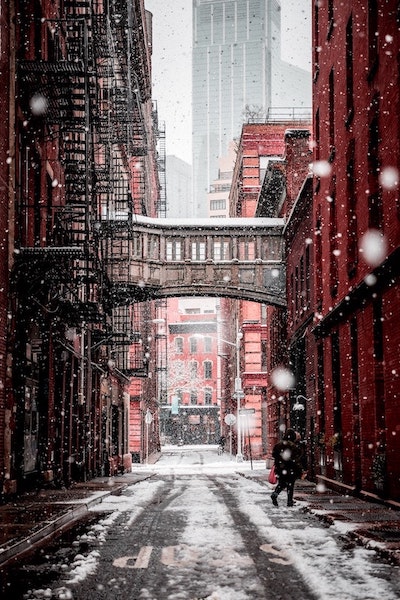The Haunted Bridge
It’s not often a bridge forgets where it’s supposed to be.
But should you need to travel between the fifth floors of Fowler’s Furniture Factory and Flammel’s Flannel Mill on a full moon night in February, you’ll find just such a bridge — or lose it, as it were.
There were five of us the night we discovered the bridge’s disappearing act. Five school friends bundled in our dark wool coats, with lanterns burning and swaying in our hands, chatting excitedly as we trespassed to play midnight games in those long-retired, decaying quarters.
Snow fell lightly upon us as we arrived.
The utter darkness and eeriness of Flammel’s Flannel Mill crept into our bones when we found a way through a broken, askew door into the ground floor. Old lint as thick as pie coated the windows, the ground, the very walls. It webbed between toppled shelves and spread like fuzzy mold through the doorways. Our conversations were oddly muffled by the coat of lint, and so we talked little.
We laughed nervously at how little good our lanterns did in the thick black of that building. And we chose to climb the center staircase until we found the bridge seen from outside that’d take us across to Fowler’s. That building was on the moon’s side of things, and hopefully less steeped in night.
We found it with little trouble and cheerfully began to chat again.
The narrow foot bridge passing between the two factories was enclosed, with small, evenly spaced rows of windows stretching the length of each side. The aged glossed floorboards protested loudly, some heavily cracked and showing signs of rot. We reached the center and walked around a curious circular patch of poorly mended flooring.
“It looks like a spot something might’ve fallen through,” Madeline commented, shaking off a shiver. She tucked a lock of raven hair behind an ear and bit her bottom lip. “Hopefully a cart of some kind and not a person.”
With this uncomfortable thought we began to tread lightly, as though softer footfalls would lessen our weights. I snuffed the urge to turn back—we were already beyond halfway across, and by the telltale shafts of light spilling through the other end, we were right about the brightness of the furniture factory on the other side.
Its windows were taller and wider. Cleaner, as though it fell into neglect only recently. Moonlight, starlight, and a vestige of glow that came from a dozen street lamps below filtered in. It was a fact we should have perhaps wondered at — those lamps lit in this abandoned part of town — but we didn’t question it and moved to set up our lanterns in different rooms as safe bases for our hiding game.
We didn’t play long. The charm of sneaking into a warehouse at night dissipated and we found we’d rather be anywhere but there.
But we soon stared at a patch of brick wall, dumbfounded. A couple of us laughed in disbelief, a few shifted nervously on their feet.
“We’ve been up and down multiples times and this is for sure the fifth floor. How could we lose a bridge?” I asked, reaching out to knock the brick where the bridge’s entrance should have been. My knuckles stung, and there was no echo beyond. “Let’s find another way out. A door or window on the ground floor.”
We had only avoided it fearing getting caught trespassing on the better lit side of the buildings.
Wordlessly, four of us filed toward the exit of the room toward the center of the warehouse and the wide twisting wrought-iron staircase that would lead us below. Clyde, however, the oldest and perhaps the bravest being the only one of us to willingly enlist recently in the army, stood still and kept an eye on the wall. He cocked his head when I passed him, as though he heard something.
I was about to turn and follow his line of sight when a cool draft of wind rushed past. It was strong enough the girls’ hair whipped in a frenzy behind them. Old stacks of papers lifted from desks and scattered like giant flakes of snow.
Our lanterns blew out. The night flooded in and enveloped us like an avalanche.
The rest of us turned as one, slowly, back toward the wall of the disappearing bridge, where the wind rushed to.
A gaping hole watched us—no bridge stretched there, just inky darkness through a giant mouth of jagged brick and splinted wood.
Clyde was gone.
And the humming began.

